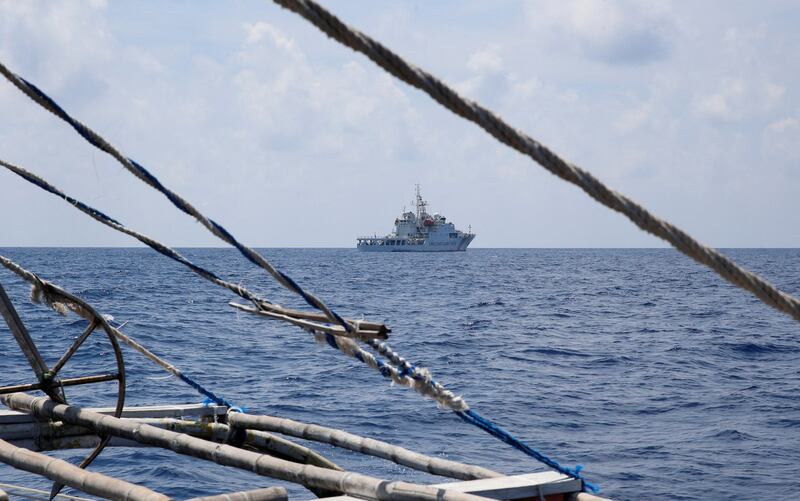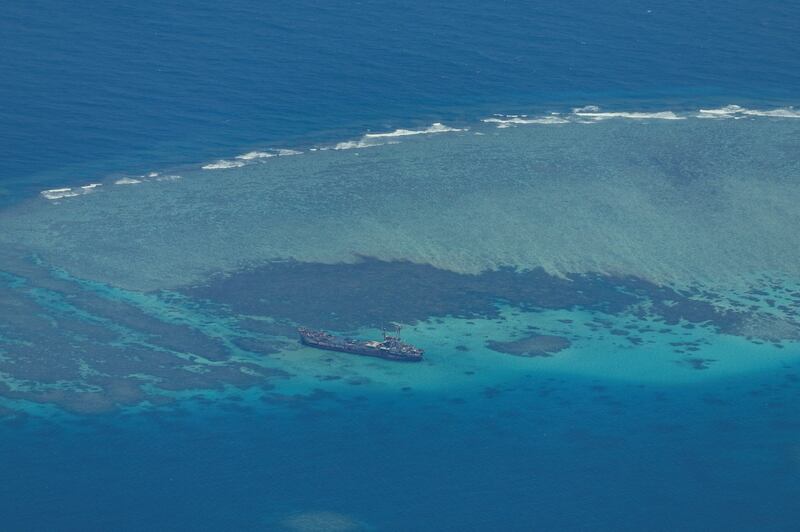Updated Oct. 10, 2023, 06:20 a.m. ET.
The Philippines’ military chief on Tuesday rejected a claim that its navy vessel was driven away from a disputed reef in the South China Sea by the Chinese coast guard, calling it “Beijing’s propaganda.”
Early on Tuesday, the China Coast Guard said a Philippine Navy gunboat came into China’s “jurisdictional waters” near the Scarborough Shoal in the Spratly Islands.
“On Oct. 10, a Philippine Navy gunboat intruded into the waters adjacent to China’s Huangyan Island, ignoring China’s repeated warnings,” Chinese Coast Guard spokesperson Gan Yu said in a statement, using the Chinese name for a shoal the Philippines calls Bajo de Masinloc.
Gan said that China Coast Guard ships “took necessary measures, such as tracking and controlling the ship’s route, to drive away the Philippine vessel according to the law.”
Beijing’s claim – which comes against a backdrop of deteriorating relations between the neighbors – was rejected by the Philippines’ top military commander, who denied such an incident had taken place.
“That is just propaganda from Beijing … to show that they are doing something,” Gen. Romeo Brawner Jr. told RFA-affiliated news organization BenarNews on Tuesday.
A Philippine navy boat was in the vicinity of Bajo de Masinloc, but it was carrying out a maritime patrol.
“It was sailing and it just so happened that the China Coast Guard was there and we issued a challenge,” Brawner said. “Our ship continued with its mission.
He added the boats were “far” away from each other.

Both Beijing and Manila claim sovereignty over Scarborough Shoal, which China seized after a standoff with the Philippines in 2012 and has maintained control over since.
The Chinese spokesperson accused the Philippines of violating China's sovereignty over the shoal, adding: “We call on the Philippines to immediately stop its infringement.”
On Monday, the Chinese Foreign Ministry also warned Manila against "making provocations and creating troubles at sea," saying "China has made serious démarches [diplomatic protests] to the Philippines on multiple occasions."
The ministry was responding to a statement by the Philippines on Saturday that China's "unfounded" claims in the South China Sea and Beijing’s actions there are “irresponsible.”
‘Stirring up trouble’
The latest incident marks a further deterioration in the relationship between the two neighbors.
A Beijing-based think tank, the South China Sea Probing Initiative (SCSPI), accused the Philippines of “stirring up” the situation in the sea.
This week, U.S. and Philippine warships are conducting a bilateral training exercise called Samasama (Together) 2023 in the waters off the Philippines. The exercise, joined by several other U.S. allies, is being seen as a testament of the strong bond between the two militaries.
"Currently, the Philippines is at the vanguard of challenging China at sea, much more aggressive than any other party including the United States," SCSPI said in a post on the social media platform X, formerly Twitter.
“Wait and see,” it added in a thinly veiled threat, “The Scarborough Shoal Incident in 2012 is a wake-up call for both China and the Philippines.”
The 2012 standoff began on April 8, 2012, after the Philippine Navy attempted to arrest Chinese fishermen who it accused of illegal fishing in the waters near Scarborough Shoal but the attempt was blocked by Chinese maritime surveillance ships.
Naval vessels from both sides were deployed in the standoff that lasted more than two months. The Philippines pulled its two vessels out on June 15, 2012, but China kept its ships at the shoal.
Scarborough Shoal has since become a hot spot and a trigger point between China and the Philippines in the contested South China Sea. Most recently, in late September, the Philippines said China had installed a 300-meter (984-foot) floating barrier to block Philippine fishermen from accessing the waters around the shoal.
The Philippine coast guard carried out a “special operation” to cut the barrier and remove its anchor.

The risk of confrontation has also risen in recent days over another disputed atoll in the South China Sea, internationally known as the Second Thomas Shoal.
The Philippines calls it Ayungin Shoal, where it maintains an outpost with less than a dozen marines, stationed on a rusty WWII landing craft, the BRP Sierra Madre.
Manila accuses China of regularly blocking its resupply missions to the troops on the Sierra Madre. It said on Aug. 6, 2023, Chinese Coast Guard ships fired a water cannon at one of the Philippine ships resupplying the outpost.
China calls it Ren’ai Jiao and maintains that the atoll lies within its jurisdiction.
Six parties – China, the Philippines, Brunei, Malaysia, Vietnam, and Taiwan – claim parts of the resource-rich South China Sea together with the islands inside but Beijing’s claim is by far the most extensive, occupying nearly 90% of the sea.
An international tribunal in 2016 ruled that China’s claims in the South China Sea were illegal and invalid, but Beijing refused to accept the ruling.
Edited by Mike Firn and Elaine Chan.
BenarNews is an RFA-affiliated online news organization.
Updated to include comment from Philippine military commander Gen. Romeo Brawner Jr.
